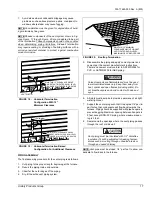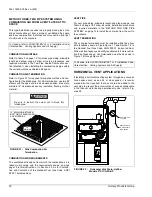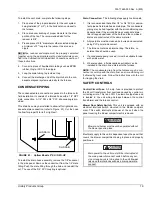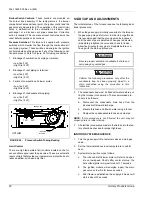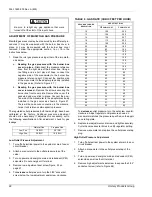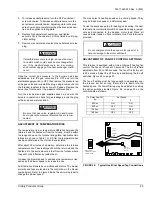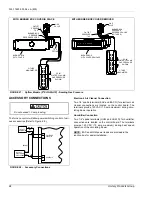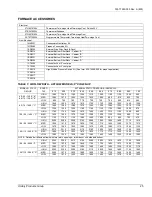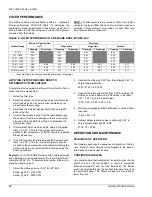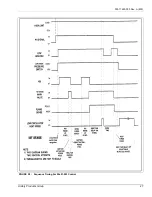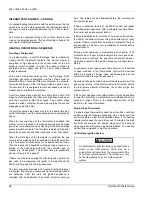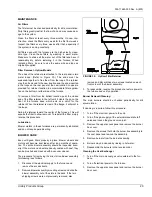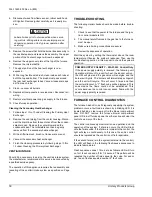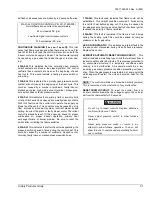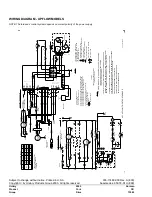
035-17480-000 Rev. A (800)
26
Unitary Products Group
FILTER PERFORMANCE
The airflow capacity data published in Table 8 represents
blower performance WITHOUT filters. To determine the
approximate blower performance of the system, apply the fil-
ter drop value for the filter being used or select an appropri-
ate value from the Table 8.
NOTE: The filter pressure drop values in Table 8 are typical
values for the type of filter listed and should only be used as a
guideline. Actual pressure drop ratings for each filter type
vary between filter manufacturer.
APPLYING FILTER PRESSURE DROP TO
DETERMINE SYSTEM AIRFLOW
To determine the approximate airflow of the unit with a filter in
place, follow the steps below:
1.
Select the filter type.
2.
Select the number of return air openings or calculate the
return opening size in square inches to determine the
proper filter pressure drop.
3.
Determine the External System Static Pressure (ESP)
without the filter.
4.
Select a filter pressure drop from the table based upon
the number of return air openings or return air opening
size and add to the ESP from Step 3 to determine the
total system static.
5.
If total system static matches a ESP value in the airflow
table (i.e. 0.20, 0.60, etc,) the system airflow corre-
sponds to the intersection of the ESP column and Model/
Blower Speed row.
6.
If the total system static falls between ESP values in the
table (i.e. 0.58, 0.75, etc.), the static pressure may be
rounded to the nearest value in the table determining the
airflow using Step 5 or calculate the airflow by using the
following example.
Example: For a 130,000 Btuh furnace with 2 return openings
and operating on high speed blower, it is found that total sys-
tem static is 0.58" w.c. To determine the system airflow, com-
plete the following steps:
1.
Obtain the airflow values at 0.50" & 0.60" ESP.
Airflow @ 0.50": 2125 CFM
Airflow @ 0.60": 2035 CFM
2.
Subtract the airflow @ 0.50" from the airflow @ 0.60" to
obtain airflow difference.
2035 - 2125 = -90 CFM
3.
Subtract the total system static from 0.50" and divide this
difference by the difference in ESP values in the table,
0.60" - 0.50", to obtain a percentage.
(0.58 - 0.50) / (0.60 - 0.50) = 0.8
4.
Multiply percentage by airflow difference to obtain airflow
reduction.
(0.8) x (-90) = -72
5.
Subract airflow reduction value to airflow @ 0.50" to
obtain actual airflow @ 0.58" ESP.
2125 - 72 = 2053
OPERATION AND MAINTENANCE
SEQUENCE OF OPERATION
The following describes the sequence of operation of the fur-
nace. Refer to the schematic wiring diagram in the back of
this manual for component location.
CONTINUOUS BLOWER
On cooling/heating thermostats with fan switch, when the fan
switch is set in the ON position, a circuit is completed
between terminals R and G of the thermostat. The blower
motor is energized through the low heat terminal and runs on
the selected speed. This allows constant air circulation at
lower flow rate.
TABLE 8: FILTER PERFORMANCE - PRESSURE DROP INCHES W.C.
Airflow Range
Minimum Opening Size
(in.
2
)
Filter Type
Disposable
Hogs Hair
*
Pleated
1 Opening
2 Openings
1 Opening
2 Openings
1 Opening
2 Openings
1 Opening
2 Openings
0 - 750
230
0.01
0.01
0.15
751 - 1000
330
0.04
0.03
0.20
1001 - 1250
330
0.08
0.07
0.20
1251 - 1500
330
0.08
0.07
0.25
1501 - 1750
380
658
0.14
0.08
0.13
0.06
0.30
0.17
1751 - 2000
380
658
0.17
0.09
0.15
0.07
0.30
0.17
2001 & Above
463
658
0.17
0.09
0.15
0.07
0.30
0.17
*.
Hogs Hair Filters are the type supplied with furnace (if supplied).






